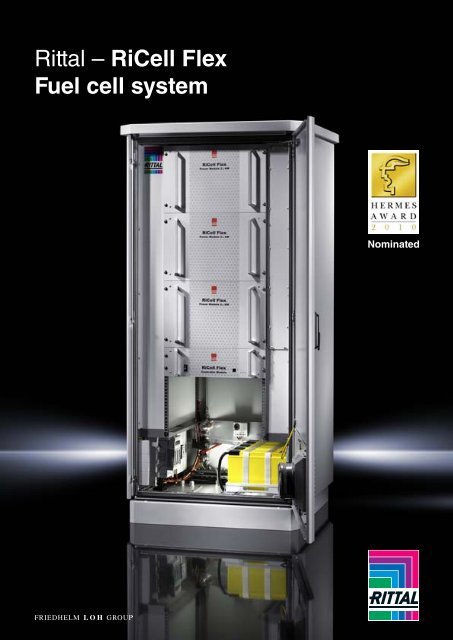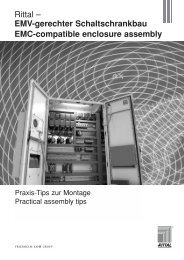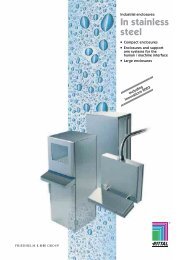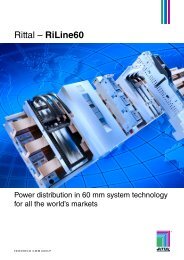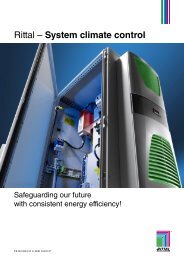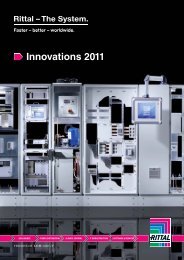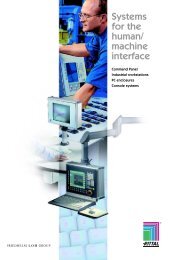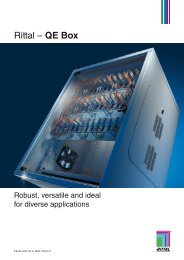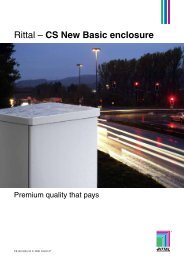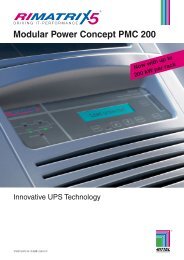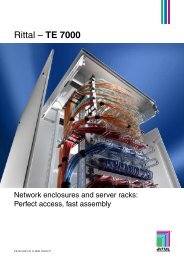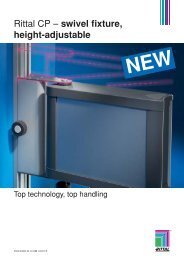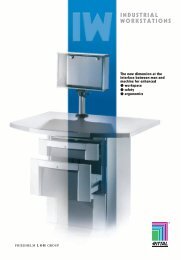You also want an ePaper? Increase the reach of your titles
YUMPU automatically turns print PDFs into web optimized ePapers that Google loves.
<strong>Rittal</strong> <strong>–</strong> <strong>RiCell</strong> <strong>Flex</strong><br />
<strong>Fuel</strong> <strong>cell</strong> <strong>system</strong><br />
Nominated
<strong>RiCell</strong> <strong>Flex</strong> fuel <strong>cell</strong> <strong>system</strong><br />
Efficient, autonomous and robust<br />
Reliable, efficient and environment-friendly emergency<br />
power supplies for critical infrastructures <strong>–</strong> that is the<br />
domain of the <strong>Rittal</strong> fuel <strong>cell</strong> <strong>system</strong>. This modular,<br />
scalable solution guarantees ultimate flexibility in terms<br />
of both output and autonomy time, and copes admir-<br />
ably with the most varied ambient conditions.<br />
Its particular strengths are to be seen in its ecological<br />
compatibility and outstanding economic parameters:<br />
Telecommunications<br />
<strong>Fuel</strong> <strong>cell</strong>s are substitutes for battery-powered<br />
backup <strong>system</strong>s. Particularly in mobile<br />
telecommunication, the freely scalable<br />
backup time has proved a major advantage.<br />
The longer the autonomy time, the more<br />
lucrative it becomes to use fuel <strong>cell</strong>s. Mobile<br />
telecommunication centres and temporary<br />
telephone booths for events are just two of<br />
the many direct power supply applications.<br />
Traffic<br />
Suitable as a mobile primary power supply<br />
for emergency use at the scene of an accident,<br />
for example for illumination or temporary<br />
traffic signs. Emergency power can also<br />
be provided at a variety of supply voltages<br />
to <strong>system</strong> control centres, for example for<br />
railway networks, along major waterways or<br />
at airports.<br />
● High service friendliness<br />
● Emission-free power supply<br />
IT<br />
The classic emergency power supply application.<br />
<strong>Fuel</strong> <strong>cell</strong> <strong>system</strong>s provide for additional<br />
redundancy in extremely critical highavailability<br />
applications, and serve to replace<br />
ecologically harmful fossil-fuel generators.<br />
As primary power sources, fuel <strong>cell</strong>s are<br />
able to handle the short-time deployment of<br />
mobile data centres.<br />
Mining/tunnel engineering<br />
The extreme conditions encountered in tunnels<br />
or mines demand robust technical solutions.<br />
<strong>Rittal</strong> has gathered a wealth of knowhow<br />
in reliable packaging for sophisticated<br />
technologies. <strong>Fuel</strong> <strong>cell</strong> <strong>system</strong>s are thus<br />
especially suitable as emergency power<br />
supplies to maintain the control and monitoring<br />
<strong>system</strong>s or lighting installations of critical<br />
infrastructures in the fields of mining and<br />
tunnel engineering.<br />
● Scalable output (2.5 kW per module)<br />
● Suitable for both indoor and outdoor applications<br />
● High electrical efficiency<br />
● Remote control<br />
With such versatility, the fuel <strong>cell</strong> <strong>system</strong> represents<br />
a convincing power supply for a broad range of appli-<br />
cations.<br />
Energie<br />
<strong>Fuel</strong> <strong>cell</strong> <strong>system</strong>s are predestined for use in<br />
combination with renewable energy solutions,<br />
and to support and safeguard power<br />
generation infrastructures. Ideally, they can<br />
be integrated directly into the DC applications<br />
for power station control. Both temporary<br />
power supplies and backup functions<br />
are significant.<br />
Environment<br />
As a consequence of the integration of<br />
renewable energy sources (photovoltaics,<br />
wind, etc.), load balancing and the maintenance<br />
of <strong>system</strong> stability have become<br />
major challenges in modern power supply<br />
networks. Thanks to their immediate availability,<br />
fuel <strong>cell</strong>s can serve as passive balancing<br />
energy (a particular location supplies<br />
itself) or combined into a virtual power station<br />
also as active balancing energy.<br />
2 <strong>Rittal</strong> <strong>Fuel</strong> <strong>cell</strong> <strong>system</strong>
Application:<br />
● Emergency power supplies,<br />
e. g. for mobile telecommunication<br />
base stations<br />
● Indoor and outdoor use<br />
● Temporary power supplies<br />
● UPS applications<br />
● High-availability applications<br />
● Balancing energy supplies<br />
Width (B) mm 850<br />
Height (H1) mm 1200 <strong>–</strong> 2000 1)<br />
Depth (T) mm 850<br />
Base/plinth height mm 100<br />
Overall height (H2) mm 1300 <strong>–</strong> 2100 1)<br />
<strong>Rittal</strong> <strong>Fuel</strong> <strong>cell</strong> <strong>system</strong><br />
Material:<br />
Enclosure frame:<br />
Stainless steel 1.4301 (AISI 304)<br />
Door, side panels, roof:<br />
Aluminium AlMg3,<br />
powder-coated<br />
in RAL 7035<br />
Photo shows a configuration example with equipment not included in the scope of supply.<br />
<strong>RiCell</strong> <strong>Flex</strong> fuel <strong>cell</strong> <strong>system</strong><br />
Supply includes:<br />
Ready-to-connect fuel <strong>cell</strong> <strong>system</strong><br />
including climate control.<br />
Hydrogen supply not included.<br />
Available on request:<br />
● Higher level of cascading<br />
● Different output voltages<br />
● Housing for gas cylinders<br />
● Primary power supply<br />
<strong>Fuel</strong> <strong>cell</strong> module<br />
Power consumption 2000 watts<br />
Maximum power output 2500 watts2) Output voltage (adjustable) <strong>–</strong>44.0 to <strong>–</strong>55.5 V DC<br />
Noise generation < 60 dB(A) at distance of 1 m<br />
Weight<br />
Hydrogen supply<br />
28 kg<br />
Gas type Hydrogen, purity 99.9%, class 3.0<br />
Consumption 10 slpm (standard litres per minute) per kW<br />
Typical autonomy time<br />
Freely scalable via bottle batteries;<br />
600 l (1 bundle), 200 bar hydrogen provides for more than 24 h autonomy at 6 kW full load<br />
Input pressure<br />
Ambient conditions<br />
12.0 to 20.0 bar<br />
Temperature range <strong>–</strong>33°C to +45°C<br />
Relative humidity 5% to 95%, non-condensing<br />
Height above mean sea level<br />
Monitoring<br />
<strong>–</strong>60 m to 2000 m; thereafter 5% power reduction per 1000 m<br />
Programmable start voltage Freely selectable within voltage range<br />
Interfaces Ethernet TCP/IP<br />
Software Web-based user interface with display for status, event log and control<br />
Alarm outputs<br />
1) Dependent on number of modules.<br />
2) Begin of life (BOL).<br />
4 floating contacts: “H2 low”; “Non-critical error”; “Serious error”; “FC in operation”<br />
T<br />
B<br />
H1<br />
H2<br />
3
<strong>RiCell</strong> <strong>Flex</strong> fuel <strong>cell</strong> <strong>system</strong>. Your direct line to us.<br />
Application:<br />
❑ Indoor ❑ Outdoor<br />
Output range: ______________ kW Output voltage: ______________ V ❑ DC ❑ AC<br />
From:<br />
Name<br />
First name<br />
Company/customer no.<br />
Department/function<br />
We would be pleased to meet you in person<br />
to offer our advice.<br />
How it works<br />
<strong>Fuel</strong> <strong>cell</strong><br />
<strong>Fuel</strong> <strong>cell</strong>s convert the chemical<br />
energy arising from the reaction<br />
between hydrogen (H2) and<br />
oxygen (O2) directly into electrical<br />
energy, water and heat.<br />
● A fuel <strong>cell</strong> essentially consists<br />
of two electrodes separated<br />
from each other by an<br />
electrolyte.<br />
● At one electrode, the hydrogen<br />
is separated into positively<br />
charged protons and<br />
negatively charged electrons.<br />
Address<br />
Telephone<br />
E-mail<br />
<strong>Rittal</strong> GmbH & Co. KG � Postfach 1662 � D-35726 Herborn<br />
Telephone: +49(0)2772 505-0 � Telefax: +49(0)2772 505-2319 � eMail: info@rittal.de � www.rittal.com<br />
● At the other electrode, oxygen<br />
molecules (O2) are dissociated<br />
(separated) and are<br />
able to absorb electrons at<br />
the electrode.<br />
● The H2 ions pass through the<br />
electrolyte to the positive<br />
electrode where they react<br />
with the O2 ions to form<br />
water.<br />
● The two electrodes are connected<br />
to one another via an<br />
external load so that an electric<br />
current flows. The flow of<br />
current is supplied directly by<br />
converting a significant portion<br />
of the chemical energy<br />
from hydrogen and oxygen<br />
into electrical energy.<br />
04/10 � E680


